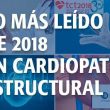Courtesy of Dr. Carlos Fava. The aetiology of mitral regurgitation (MR) may be divided into primary, organic or degenerative MR, and secondary or functional MR. These two present different physiopathology. The treatment strategy is different for each, and edge-to-edge treatment with Mitraclip is currently emerging as a valid alternative for high-risk patients. This study analyzed 943 patients...
The Most Read Scientific Articles in Interventional Cardiology
1- Long-Term Foramen Ovale Closure after Cryptogenic Stroke Patent foramen ovale closure is the standard treatment for cryptogenic stroke patients. However, there are is little information on its long-term evolution. Read more 2- Descending Thoracic Aortic Aneurysms: Is There a New Plan A? The last available evidence suggests that open surgery should be the...
Promising Results for Tricuspid Repair
Courtesy of Dr. Carlos Fava. Tricuspid regurgitation (TR) is more common than we thought. Around 1.6 million people in the US and over 3 million in Europe experience significant TR. It usually has a functional cause and its negative impact on patient prognosis is strong. Its surgical treatment is challenging, and it is important that its resolution...
Mitral Valve Repair with MirtaClip Was Feasible and Safe
Transcatheter mitral valve repair (TMVR) with MitraClip was shown feasible and safe, and therefore a viable option for symptomatic patients with severe mitral valve regurgitation of prohibitive risk. In this regard, the procedure alleviates symptoms, cardiac regurgitation and has a potential benefit on ventricular remodeling. However, many patients presented atrial fibrillation (AF) and mitral valve...
Long Term Effect of Low Dose Paclitaxel Coated Balloon
The beneficial effect of low dose drug coated balloons with paclitaxel is sustained in time according to this randomized study. In a nutshell, this study has shown a significant statistical difference in favor of paclitaxel coated balloons vs. conventional PCI at 2 years. The safety and efficacy of new generation low dose drug coated balloons...
The Most Important Articles of 2018 in Structural Heart Diseases
1- ESC 2018 | MITRA FR: Testing MitraClip for Secondary Mitral Regurgitation In secondary mitral regurgitation, mitral-valve leaflets and chordae are structurally normal and mitral regurgitation results from alterations in left ventricular geometry and function. Read more 2- TCT 2018 | COAPT: MitraClip in Patients with Secondary Mitral Regurgitation The prognosis of patients with...
More Evidence for the “Forgotten Valve.” Results from the TriValve Registry
Transcatheter tricuspid valve replacement is feasible with different devices, with a reasonable procedural success rate, and is associated with low peri-procedural mortality and significant clinical improvement. Mid-term survival was favorable in this high-risk population. Greater leaflet coaptation depth was associated with reduced procedural success, which, unsurprisingly, turned out to be an independent predictor of mortality....
SOLACI@SOVECI Symposium at the XVI Venezuelan Congress on Interventional Cardiology
The XVI Venezuelan Congress on Interventional Cardiology will take place next Saturday, December 1st, 2018, at La Trinidad Teaching Medical Center (Caracas). SOLACI is honored to contribute with the organization of this event by means of two symposiums addressing important issues related with Interventional Cardiology on Structural Heart Disease. Here is the detailed information for...
TCT 2018 | FAST-FFR: Angiography-Derived FFR Without Hyperemic Stimulus or Invasive Guidewire Placement
All over the world, functional lesion measurement remains underutilized due to the need for a hyperemic stimulus (which may be avoided with instantaneous wave-free ratio [iFR]) and, above all, the invasiveness of guidewire placement (crossing the intended lesion) for the measurement. These guidewires have improved a lot, but they still lack the navigating capacity of...
TCT 2018 | Mismatch After TAVR According to the TVT Registry
Prosthesis-patient mismatch (i.e. a difference between the size of the implanted prosthetic valve and the patient body size) in patients who undergo surgery is associated with worse outcomes. This may also apply to percutaneous prostheses, although that has not been well-studied yet. This work, presented at TCT 2018 and published simultaneously in JACC, analyzes this problem...









